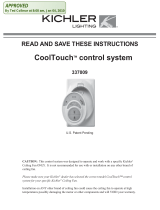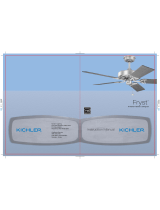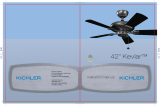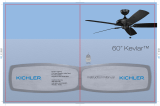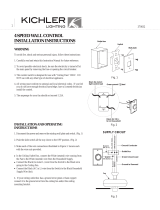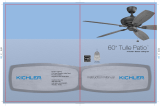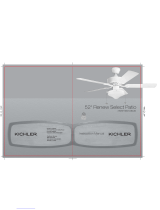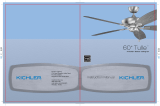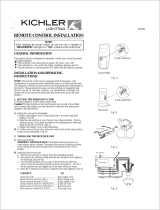Page is loading ...

2*
2*
Kichler
®
Lighting
7711 East Pleasant Valley Road
P.O. Box 318010
Cleveland, Ohio 44131-8010
Customer Service
866.558.5706
8:30 AM to 5:00 PM EST,
Monday - Friday
Instruction Manual
Hatteras Bay
TM
Patio
A Kichler
®
Décor
™
ceiling fan
Designed to coordinate with a popular Kichler Lighting collection.
Includes our new
CoolTouch
TM
Control System
Looks permanent, but goes wherever you go!
U.S. Patent Pending

1. To reduce the risk of electric shock, insure
electricity has been turned off at the circuit
breaker or fuse box before beginning.
2. All wiring must be in accordance with the
National Electrical Code and local electrical
codes. Electrical installation should be
performed by a qualified licensed
electrician.
3. WARNING: Suitable for use with solid-
state speed controls.
4. WARNING: To reduce the risk of personal
injury, use only the two steel screws (and
lock washers) provided with the outlet box
for mounting to the outlet box. Most outlet
boxes commonly used for the support of
lighting fixtures are not acceptable for fan
support and may need to be replaced,
consult a qualified electrician if in doubt.
5. The outlet box and support structure must
be securely mounted and capable of
reliably supporting a minimum of 50
pounds. Use only CUL Listed outlet boxes
marked "FOR FAN SUPPORT".
6. The fan must be mounted with a minimum
of 7 feet clearance from the trailing edge of
the blades to the floor.
7. To operate the reverse function on this fan,
press the reverse button while the fan is
running.
8. WARNING: Use only with light kit marked
"Suitable for Use in Damp Location
Locations".
9. Avoid placing objects in the path of the
blades.
10. To avoid personal injury or damage to the
fan and other items, be cautious when
working around or cleaning the fan.
11. Do not use water or detergents when
cleaning the fan or fan blades. A dry dust
cloth or lightly dampened cloth will be
suitable for most cleaning.
12. After making the electrical connections,
spliced conductors should be turned
upward and pushed carefully up into outlet
box. The wires should be spread apart with
the ground wire and white (common) wire
to one side with the black (load) wire to the
other side of the outlet box.
13. Electrical diagrams are reference only.
Light kits that are not packed with the fan
must be CUL Listed and marked suitable
for use with the model fan you are
installing. Switches must be CUL General
Use Switches. Refer to the Instructions
packaged with the light kits and switches
for proper assembly.
WARNING
TO REDUCE THE RISK OF FIRE, ELECTRIC SHOCK
OR PERSONAL INJURY, MOUNT FAN TO OUTLET
BOX MARKED "ACCEPTABLE FOR FAN
SUPPORT".
WARNING
TO REDUCE THE RISK OF PERSONAL INJURY,
DO NOT BEND THE BLADE BRACKETS (ALSO
REFERRED TO AS FLANGES) DURING ASSEMBLY
OR AFTER INSTALLATION. DO NOT INSERT
OBJECTS IN THE PATH OF THE BLADES.
1
1. SAFETY RULES
Special Notice
This appliance is equipped with a "Wattage
Limiting Device" required by the United
States Department of Energy. The device
has been installed at the factory and can not
be removed.
Installing Lamps in excess of 190 total watts
will disable the unit's light fixture. If this
should happen, you will need to reset the
lighting fixture by turning the power off to
the ceiling fan and/or light fixture,
reinstalling lamps totaling less that 190
watts and then turning the power back on.

2
3. PACKAGE CONTENTS
Unpack your fan and check the contents. You
should have the following items:
a. Fan blades (5)
b. Canopy & Ceiling mounting bracket
c. Ball/downrod assembly
d. Canopy
e. Decorative canopy bottom cover
f. Coupling cover
g. Fan motor assembly
h. Set of blade brackets (5)
i. Blade bracket medallions (5)
j. Light fixture
k. Light plate
l. 40W T3 halogen bulbs (4)
m. Receiver
n. CoolTouch
™
Control System
o. Part bag contents
1) Mounting hardware:
wood screw, flat washer, spring washer,
star washers (2), wire nuts (3),
machine screws (2), washers (2),
screws (2)
2) Blade attachment hardware:
screws (17), washers (17),
rubber washers (17)
3) Safety cable hardware:
wood screw, lock washer, flat washer
4) Balance Kit
Philips screw driver
Blade screw driver
11 mm wrench
Step ladder
Wire cutters
2. TOOLS AND MATERIALS REQUIRED
a
b
c
d
e
g
h
i
f
m
n
o
l
j
k
Hatteras Bay
TM
Patio

3
4. MOUNTING OPTIONS
If there isn't an existing UL (cUL for Canadian
Installation) listed mounting box, then read the
following instructions. Disconnect the power by
removing fuses or turning off circuit breakers.
Secure the outlet box directly to the building
structure. Use appropriate fasteners and
building materials. The outlet box and its
support must be able to fully support the
moving weight of the fan (at least 50 lbs). Do
not use plastic outlet boxes.
NOTE: If you are installing the ceiling fan on a
sloped (vaulted) ceiling, you may need a
longer downrod to maintain proper clearance
between the tip of the blade and the ceiling. A
minimum clearance of 12" is suggested for
optimal operation.
NOTE: Depending on the location you have
selected for installation, you may need to
purchase and install a "Joist Hanger" for the
support of the outlet box. Make sure the joist
hanger you purchase has been designed for
use with ceiling fans. (Fig. 4)
Outlet box
Provide strong
support
Recessed
outlet box
Ceiling
mounting
plate
Outlet box
Fig. 1
Fig. 3
Fig. 4
Outlet box
Fig. 2
ANGLED CEILING
MAXIMUM 20
°
ANGLE

4
Fig. 6
Mounting screws
(supplied with
electrical box)
Hook
Ceiling
mounting
bracket
UL Listed
outlet box
120V Wires
Washers
Cross pin
Hanger
ball
Set screw
Fig. 5
Supply wires
Downrod
Retaining pinHitch pin
Set screws
Coupling
Set screws
Hatteras Bay
TM
Patio
NOTE: This ceiling fan is supplied with two
types of hanging assemblies; the standard
ceiling installation using a downrod and
canopy mounting system and a "close to
ceiling" Canopy ONLY system. The
"close-to-ceiling" installation is recommended
in rooms with less than 8-foot ceilings or in
areas where additional space is desired from
the floor to the fan blades. Once you have
selected which mounting system you will use,
proceed with the following instructions. Where
necessary, each section of the instructions will
note the different procedures to follow for the
two types of mounting.
REMEMBER to turn off the power before you
begin.
To properly install your ceiling fan, follow the
steps below.
Step 1. Pass the 120 volt supply wires from
the ceiling outlet box through the center of the
ceiling mounting bracket. (Fig.5)
Step 2. Attach the ceiling mounting bracket to
the outlet box using the screws and washers
included with the outlet box. (Fig. 5)
Step 1. Remove the hanger ball from the
downrod assembly by loosening the set screw,
removing the cross pin and sliding the ball off
the rod. (Fig.6)
Step 2. Loosen the two set screws and
remove the hitch pin and retaining clip from
the coupling on top of the motor assembly.
(Fig. 6)
Step 3. Carefully feed the electrical lead wires
from the fan up through the downrod. Thread
the downrod into the coupling until the Hitch
pin holes are aligned.
5. HANGING THE FAN
STANDARD CEILING INSTALLATION
Canopy
Canopy cover
Coupling cover

5
Fig. 8
Fig. 7
Registration slot
Fig. 9
Check tab
Hook
Canopy
Decorative
mounting
screw
cover
Screws and Lock washers
(3 of 6 places)
Coupling
Next, replace the hitch pin and retaining clip.
Tighten both set screws. (Fig. 6)
Step 4. Slip the coupling cover, canopy cover
and canopy onto the downrod.
Thread the hanger ball onto the downrod,
insert the cross pin through the downrod and
tighten. Now tighten the set screw. (Fig. 6)
Step 5. Lift the motor assembly into position
and place the hanger ball into the ceiling
mounting bracket.
Rotate the entire assembly until the "Check
Tab" has dropped into the "Registration Slot"
and seats firmly. (Fig. 7)
The entire motor assembly should not rotate
(left or right) when seated properly.
WARNING: Failure to properly seat the
"Check Tab" can damage the ceiling fan
during operation.
Step 1. Remove three of the six screws and
lock washers (every other one) from the collar
on top of the motor assembly. Place the ceiling
fan canopy over the collar and align the
mounting holes with the holes in the collar.
Attach the canopy with the three screws and
lock washers previously removed. (Fig. 8)
WARNING: Failure to completely tighten the
three mounting screws in step 1 could result in
the fan possibly falling from the ceiling.
Step 2. Push the decorative mounting screw
cover down and off the canopy letting it rest on
top of the motor housing (Fig. 8) and hang the
fan on the mounting bracket by inserting the
hook on the inside edge of the mounting
bracket through one of the screw holes in the
ceiling canopy. (Fig. 9) This will allow you to
have both hands free to make the wiring
connections.
CLOSE-TO-CEILING INSTALLATION

6
Fig. 10
7. ELECTRICAL CONNECTIONS
6. INSTALLATION OF SAFETY SUPPORT
(for Canadian Installation ONLY)
A safety support cable is provided to help
prevent the ceiling fan from falling, please install
it as follows.
Step 1. Attach the provided wood screw and
washer to the ceiling joist next to the mounting
bracket but do not tighten. (Fig. 10)
Step 2. Adjust the length of the safety cable to
reach the screw and washer by pulling the extra
cable through the cable clamp until the overall
length is correct. Put the end of the cable back
through the cable clamp, forming a loop at the
end of the cable. Tighten the cable clamp
securely. Now, put the loop in the end of the
safety cable over the wood screw and under the
washer. Tighten the wood screw securely.
Ceiling mounting
bracket
Attach safety cable
to ceiling joist with
screw and washer
Fig. 11
Fig. 12
Code switch
Receiver
Ceiling mounting
bracket
WARNING: To avoid possible electrical shock,
be sure you have turned off the power at the
main circuit panel.
Follow the steps below to connect the fan to
your household wiring. Use the wire connecting
nuts suppled with your fan. Secure the
connectors with electrical tape. Make sure there
are no loose wire strands or connections.
NOTE: The CoolTouch™ Control System is
equipped with 16 possible frequency
combinations to prevent interference from or
with other remote control units. The frequency
switches on your receiver and transmitter have
been preset at the factory. Please recheck to
make sure the switches on transmitter and
receiver are set to the same position, any
combination of settings will operate the fan as
long as the transmitter and receiver are set to
the same position. (Fig. 11)
Step 1. Insert the receiver into the ceiling
mounting bracket with the flat side of the
receiver facing the ceiling. (Fig. 12)
For best performance, make sure the Black
Antenna, on the end of the receiver, remains
extended and not tangled with any of the
electrical wires.
Hatteras Bay
TM
Patio

7
Fig. 13
Step 2. Motor to Receiver Electrical
Connections: (Fig. 13)
Connect the black wire from the fan to the
black wire marked "TO MOTOR L" on the
receiver.
Connect the white wire from the fan to the
white wire marked "TO MOTOR N" on the
receiver.
Connect the blue wire from the fan to the blue
wire marked "FOR LIGHT" on the receiver.
Secure each set of wire connections with the
plastic wire nuts provided in the parts bag.
Step 3. (Fig. 13) Receiver to House Supply
Wires Electrical Connections:
Connect the black (hot) wire from the ceiling to
the black wire marked "AC in L" from the
receiver.
Connect the white(neutral) wire from the
ceiling to the white wire marked "AC in N" from
the Receiver.
Secure the wire connections with the plastic
wire nuts provided.
Step 4. (Fig. 13) If your outlet box has a
ground wire (green or bare copper) connect it
to the fan ground wires; otherwise connect the
hanging bracket ground wire to the mounting
bracket. Secure the wire connection with a
plastic nut provided. After connecting the
wires, spread them apart so that the green
and white wires are on one side of the outlet
box and black and blue wires are on the other
side. Carefully tuck the wire connections up
into the outlet box.
Note: Fan must be installed at a maximum
distance of 30 feet from the CoolTouch™
Remote Transmitter for optimal signal
transmission between the transmitter and the
fan's receiving unit.
White (neutral)
White (neutral)
Green or bare
copper (ground)
White ("AC IN N")
White ("to motor N")
Ground
(green)
(Connect to
ground wire on
hanger bracket
if no house
ground wire
exists.)
Outlet box
Black (hot)
Black ("AC IN L")
Black ("to motor L")
Receiver
Blue (for light)
Blue (for light)
Black (motor)

Fig. 15
8
Hatteras Bay
TM
Patio
Fig. 14
Outlet box
Ceiling mounting
bracket
Canopy
Canopy cover
Screws
Outlet box
Ceiling mounting
bracket
Canopy
Screws
Decorative
mounting
screw cover
CLOSE-TO-CEILING INSTALLATION
CLOSE-TO-CEILING INSTALLATION
Remove the fan from the hook on the ceiling
mounting bracket. Attach the fan assembly to
the ceiling mounting bracket using 4 screws at
the top edge of the canopy. Insert each screw
through the canopy mounting hole and into the
mounting bracket. Tighten all screws securely.
Slide the decorative mounting screw cover up
to cover the mount screw heads. (Fig. 15)
8. FINISHING THE INSTALLATION
STANTARD CEILING INSTALLATION
STANTARD CEILING INSTALLATION
Step 1. Tuck all the connections neatly into the
ceiling outlet box.
MAKE SURE the Black Antenna wire on the
receiver remains free from all other wires.
Step 2. Slide the canopy up to ceiling and over
the two screws on hanger bracket. Rotate
canopy clockwise, next, while holding the
canopy with one hand, slide the canopy cover
over the screws and rotate clockwise until
tight. NOTE: Adjust the canopy screws as
necessary until the canopy and canopy cover
are snug. (Fig.14)

Fig. 16
Fig. 17
10. INSTALLING THE LIGHT FIXTURE
CAUTION: Remove the five rubber shipping
blocks attached to the face of the motor.
These blocks keep the motor from shifting
during shipping and MUST be removed during
installation.
Step 1. Place a blade between a blade bracket
and a blade bracket medallion. Attach all three
pieces using the screws, metal washers and
fiber washers provided. (Fig. 16)
Make sure the blade is straight when set on
the blade bracket and the medallion. Tighten
each mounting screw and then repeat this
procedure for each blade.
Step 2. Attach each blade assembly to the
motor using two mounting screws for each
blade assembly. (Fig 16)
NOTE: Make sure these mounting screws are
securely tightened.
1. Loosen the padlock on one side of the light
fixture allowing the lens holder to open.
NOTE: Be careful not to drop the lens as the
holder opens and then carefully lay it aside
before continuing.
2. Loosen the two screws on the mounting ring
attached to the motor shaft and "remove" and
save the third screw. (Fig. 17)
3. Place the key hole slots on the light fixture
over the two screws previously loosened on
the mounting ring.
Turn the light fixture until is locks in place at
the narrow section of the key hole slots.
Tighten both key hole screws and replace the
third screw previously removed and tighten
securely.
Blades bracket
Blade bracket
medallions
Blades
Glass plate
Screws
Padlocks
Mounting ring
Light fixture
Screws
Washers
Rubber
washers
9. ATTACHING THE FAN BLADES
9

Fig. 18
Fig. 19
Step 1. Install 4, 40W T3 halogen bulbs
(provided). (Fig. 19)
Step 2. Place the light fixture lens back into the
lens holder and close the light fixture. Make
sure to lower the padlock and tighten to
prevent the lens holder from coming open.
(Fig.19)
12. INSTALL THE LIGHT BULBS
Step 1. Loosen the three mounting screws on
the inside of the light fixture.
Hold the light plate close to the light fixture and
connect the white wires from the light plate
and the fan. Follow the same procedure with
the black wire connectors. (Fig. 18)
Step 2. Tuck the connections neatly into the
light fixture.
NOTE: Be careful not to pinch the light plate
wires between the light plate and the light
fixture.
Step 3. Place the light plate key holes over the
three mounting screws inside the light fixture
and turn the light plate until it locks in place at
the narrow section of the key hole slots.
Secure by tightening all three screws. (Fig. 18)
11. INSTALLING THE LIGHT FIXTURE
Light fixture
Wire connector
Mounting screws
Light plate
Bulbs
Light plate
Padlocks
Glass lens
Light fixture
10
Hatteras Bay
TM
Patio

Fig. 20
Fig. 21
Remove the battery compartment cover on the
back of the CoolTouch™ Transmitter and
insert both batteries provided. Make sure the +
sign is facing up.
Take care during this procedure NOT TO
move the frequency dip switches inside this
compartment. The settings MUST remain the
same as the settings on the receiver for proper
communication with the control system.
It's a good idea to remove these batteries if
your fan is not used for extend periods of time,
(months).
14. OPERATING INSTRUCTIONS
Restore power to ceiling fan and test for
proper operation.
A. , , and buttons:
These three buttons are used to set the
fan speed as follows:
= low speed
= medium speed
= high speed
B. button:
This button turns the fan off.
C. The " " and " " button:
The " " button turns the upper light ON or
OFF and also controls the brightness setting.
The " " button turns the bottom light ON or
OFF and also controls the brightness setting.
Press and hold either button to set the desired
brightness level. The next time you turn the
light on, the system will remember this setting.
Press and release either button to turn the
light ON or OFF.
D. The " " button is used to set the fan in
forward or reverse operation. Each time you
press this button the fan blades will reverse
direction. This button functions ONLY when
the fan blades are in operation.
13. INSTALLING THE BATTERIES
11

Fig. 22
Fig. 23
Speed settings for warm or cool weather
depend on factors such as the room size.
Ceiling height, number of fans and so on.
Warm Weather Operation: Forward (counter
clockwise) A downward airflow creates a
cooling effect as shown in Fig. 22. This allows
you to set your air conditioner on a warmer
setting without affecting your general comfort.
Cool Weather Operation: Reverse (clockwise).
An upward airflow moves warm air off the
ceiling areas as shown in Fig. 23. This allows
you to set your heating unit on a cooler setting
without affecting your general comfort.
12
Hatteras Bay
TM
Patio

Fig. 24
Fig. 25
15. INSTALLING THE COOLTOUCH
™
CONTROL SYSTEM WALL PLATE
16. INSTALLING THE TRANSMITTER
1. Insert the transmitter into the wall plate by
inserting the bottom of the transmitter first and
then press the top of the transmitter into the
pocket. The transmitter will fully function from
this location or you can remove the transmitter
and use as a "Hand Held" device. (Fig. 26)
2. To remove the transmitter from the wall
plate, push the release button and the
transmitter will fall into your hand.
Release
button
Fig. 26
Wall plate
Switch
Outlet box
Select a location to install your CoolTouch™
Control System Transmitter. You can replace
an existing wall switch or, install the transmitter
on ANY flat surface.
Option 1: Install the control system using an
existing wall switch outlet box.
Make sure the electrical power is TURNED
OFF at the main panel before continuing.
Step 1. Remove the existing wall plate and the
old switch from the wall outlet box. Wire nut
the BLACK leads (hot) together and push back
inside the outlet box. (Fig. 24)
Step 2. Install the metal plate and CoolTouch
™
wall plate to the existing wall outlet box with 4
screws provided. Then place the two plastic
plugs into the wall plate. (Fig. 25)
Option 2: Install the control system on ANY
flat surface.
Select the desired location and use the
CootTouch™ wall plate to mark the location for
the mounting holes. Use the dry wall anchors
and screws provided and finish the installation.
Screws
Screws
Plastic plugs
CoolTouch
™
wall plate
Outlet box
Metal plate
13

18. SPECIFICATIONS
These are approximate measures. They do not include Amps and Wattage used by the light kit.
Problem
Fan will not start.
Fan sounds noisy.
Fan wobble.
Remote control
malfunction.
Solution
1. Check circuit fuses or breakers.
2. Check all electrical connections to insure proper contact. CAUTION: Make
sure the main power is OFF when checking any electrical connection.
3. Make sure the batteries are installed properly. Positive (+) side facing out.
4. Check to make sure the batteries are installed properly. (Positive + side
facing out)
5. Check to make sure the batteries are not dead.
1. Make sure all motor housing screws are snug.
2. Make sure the screws that attach the fan blade bracket to the motor hub is tight.
3. Make sure wire nut connections are not rubbing against each other or the
interior wall of the switch housing. CAUTION: Make sure main power is off.
4. Allow a 24-hour "breaking-in" period. Most noise associated with a new fan
disappear during this time.
5. If using an optional light kit, make sure the screws securing the glassware
are tight. Make sure the light bulbs are not touching any other component.
6. Do not connect the fan with wall mounted variable speed control(s).
7. Make sure the upper canopy is a short distance from the ceiling. It should not
touch the ceiling.
1. Check that all blade and blade arm screws are secure.
2. Most fan wobbling problems are caused when blade levels are unequal.
Check this level by selecting a point on the ceiling above the tip of one of the
blades. Measure this distance. Rotate the fan until the next blade is positioned
for measurement. Repeat for each blade. The distance deviation should be
equal within 1/8".
3. Use the enclosed Blade Balancing Kit if the blade wobble is still noticeable.
4. If the blade wobble is still noticeable, interchanging two adjacent (side by
side) blades can redistribute the weight and possibly result in smoother
operation.
1. Ceiling Fans with remote control systems CAN NOT be operated in
conjunction with any other control system EXCEPT a basic On/Off wall switch,
if desired.
2. Make sure the frequency dip switches in the transmitter and receiver have
identical settings.
3. Make sure the Black Antenna on the receiver is NOT tangled with any other
electrical wires and is extended around the inside of the ceiling canopy.
17. TROUBLESHOOTING
2.60'
27.50
kgs
29.70
kgs
0.45
0.38
0.29
53.6
25.0
12.0
213
146
93
4299.39
2882.59
1842.45
80.21
115.30
153.54
RPM
CFM CFM/W
N.W. G.W. C.F.
120
120
120
Fan Size
44"
Speed Volts
Amps
Watts
Low
Medium
High
14
Hatteras Bay
TM
Patio
/
